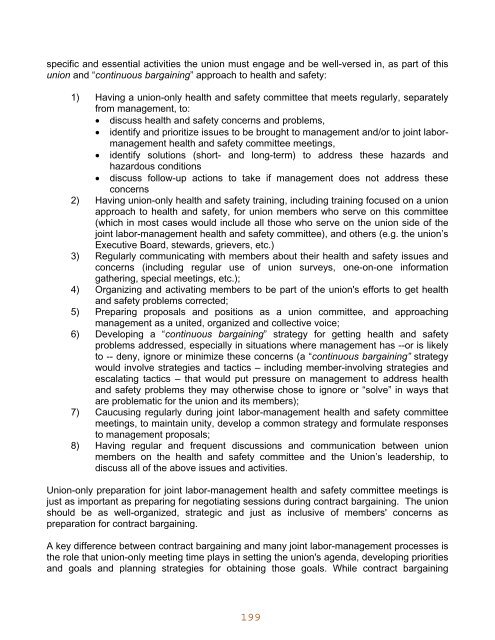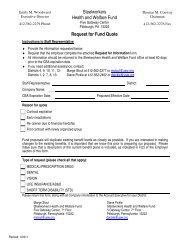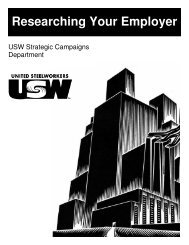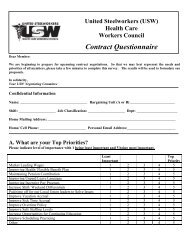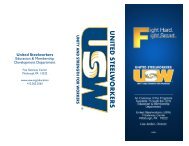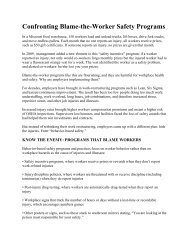Union Approach to Health and Safety: - United Steelworkers
Union Approach to Health and Safety: - United Steelworkers
Union Approach to Health and Safety: - United Steelworkers
You also want an ePaper? Increase the reach of your titles
YUMPU automatically turns print PDFs into web optimized ePapers that Google loves.
specific <strong>and</strong> essential activities the union must engage <strong>and</strong> be well-versed in, as part of this<br />
union <strong>and</strong> “continuous bargaining” approach <strong>to</strong> health <strong>and</strong> safety:<br />
1) Having a union-only health <strong>and</strong> safety committee that meets regularly, separately<br />
from management, <strong>to</strong>:<br />
discuss health <strong>and</strong> safety concerns <strong>and</strong> problems,<br />
identify <strong>and</strong> prioritize issues <strong>to</strong> be brought <strong>to</strong> management <strong>and</strong>/or <strong>to</strong> joint labormanagement<br />
health <strong>and</strong> safety committee meetings,<br />
identify solutions (short- <strong>and</strong> long-term) <strong>to</strong> address these hazards <strong>and</strong><br />
hazardous conditions<br />
discuss follow-up actions <strong>to</strong> take if management does not address these<br />
concerns<br />
2) Having union-only health <strong>and</strong> safety training, including training focused on a union<br />
approach <strong>to</strong> health <strong>and</strong> safety, for union members who serve on this committee<br />
(which in most cases would include all those who serve on the union side of the<br />
joint labor-management health <strong>and</strong> safety committee), <strong>and</strong> others (e.g. the union’s<br />
Executive Board, stewards, grievers, etc.)<br />
3) Regularly communicating with members about their health <strong>and</strong> safety issues <strong>and</strong><br />
concerns (including regular use of union surveys, one-on-one information<br />
gathering, special meetings, etc.);<br />
4) Organizing <strong>and</strong> activating members <strong>to</strong> be part of the union's efforts <strong>to</strong> get health<br />
<strong>and</strong> safety problems corrected;<br />
5) Preparing proposals <strong>and</strong> positions as a union committee, <strong>and</strong> approaching<br />
management as a united, organized <strong>and</strong> collective voice;<br />
6) Developing a “continuous bargaining” strategy for getting health <strong>and</strong> safety<br />
problems addressed, especially in situations where management has --or is likely<br />
<strong>to</strong> -- deny, ignore or minimize these concerns (a “continuous bargaining” strategy<br />
would involve strategies <strong>and</strong> tactics – including member-involving strategies <strong>and</strong><br />
escalating tactics – that would put pressure on management <strong>to</strong> address health<br />
<strong>and</strong> safety problems they may otherwise chose <strong>to</strong> ignore or “solve” in ways that<br />
are problematic for the union <strong>and</strong> its members);<br />
7) Caucusing regularly during joint labor-management health <strong>and</strong> safety committee<br />
meetings, <strong>to</strong> maintain unity, develop a common strategy <strong>and</strong> formulate responses<br />
<strong>to</strong> management proposals;<br />
8) Having regular <strong>and</strong> frequent discussions <strong>and</strong> communication between union<br />
members on the health <strong>and</strong> safety committee <strong>and</strong> the <strong>Union</strong>’s leadership, <strong>to</strong><br />
discuss all of the above issues <strong>and</strong> activities.<br />
<strong>Union</strong>-only preparation for joint labor-management health <strong>and</strong> safety committee meetings is<br />
just as important as preparing for negotiating sessions during contract bargaining. The union<br />
should be as well-organized, strategic <strong>and</strong> just as inclusive of members' concerns as<br />
preparation for contract bargaining.<br />
A key difference between contract bargaining <strong>and</strong> many joint labor-management processes is<br />
the role that union-only meeting time plays in setting the union's agenda, developing priorities<br />
<strong>and</strong> goals <strong>and</strong> planning strategies for obtaining those goals. While contract bargaining


